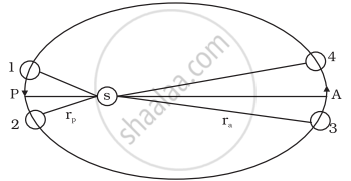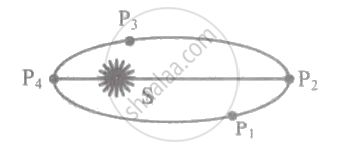Advertisements
Advertisements
प्रश्न
Earth’s orbit is an ellipse with eccentricity 0.0167. Thus, earth’s distance from the sun and speed as it moves around the sun varies from day to day. This means that the length of the solar day is not constant through the year. Assume that earth’s spin axis is normal to its orbital plane and find out the length of the shortest and the longest day. A day should be taken from noon to noon. Does this explain variation of length of the day during the year?
उत्तर
From the geometry of the ellipse of eccentricity e and semi-major axis a, the aphelion and perihelion distances are:
Angular momentum and areal velocity are constant as the earth orbits the sun
At perigee `r_p^2ω_p = r_a^2ω_a` at apogee.
If 'a' is the semi-major axis of earth's orbit, then `r_p = a(1 - e)` and `r_a = a(l + e)`
∴ `ω_p/ω_a = ((1 + e)/(1 - e))^2, e = 0.0167`
∴ `ω_p/ω_a = 1.0691`
Let ω be angular speed which is the geometric mean of ωp and ωa and corresponds to mean solar day,
∴ `(ω_p/ω) (ω/ω_a) = 1.0691`
∴ `ω_p/ω = ω/ω_a = 1.034`

If ω corresponds to 1° per day (mean angular speed), then w, = 1.034° per day and ωa = 0.967 per day. Since 361° = 14hrs: mean solar day, we get 361.034° which corresponds to 24 hrs 8.14" (8.1" longer) and 360.967° corresponds to 23 hrs 59 min 52" (7.9" smaller).
This does not explain the actual variation in the length of the day during the year.
APPEARS IN
संबंधित प्रश्न
State Kepler's law of orbit and law of equal areas.
Answer the following question.
State Kepler’s law of equal areas.
Observe the given figure showing the orbit of a planet moving around the Sun and write the three laws related to it:

The orbit of a planet moving around the Sun
A planet is revolving around the sun in an elliptical orbit as shown in figure. At which point will its K.E. be maximum?

The earth moves around the sun in an elliptical orbit as shown in the figure. The ratio, `"OA"/"OB"` = x. The ratio of the speed of the earth at Band at A is ______.

To verify Kepler's third law graphically four students plotted graphs. Student A plotted a graph of T (period of revolution of planets) versus r (average distance of planets from the sun) and found the plot is straight line with slope 1.85. Student B plotted a graph of T2 v/s r3 and found the plot is straight line with slope 1.39 and negative Y-intercept. Student C plotted graph of log T v/s log r and found the plot is straight line with slope 1.5. Student D plotted graph of log T v/s log r and found the plot is straight line with slope 0.67 and with negative X-intercept. The correct graph is of student
In our solar system, the inter-planetary region has chunks of matter (much smaller in size compared to planets) called asteroids. They ______.
If the sun and the planets carried huge amounts of opposite charges ______.
- all three of Kepler’s laws would still be valid.
- only the third law will be valid.
- the second law will not change.
- the first law will still be valid.
lf the angular momentum of a planet of mass m, moving around the Sun in a circular orbit is L, about the center of the Sun, and its areal velocity is ______.
Halley's Comet revolves around the sun for a time period of 76 years. The aphelion distance if perihelion is given by 8.9 × 1010 m, will be ______.
(Take, the mass of sun = 2 × 1030 kg and G = 6.67 × 10-11 Nm3/kg2)
